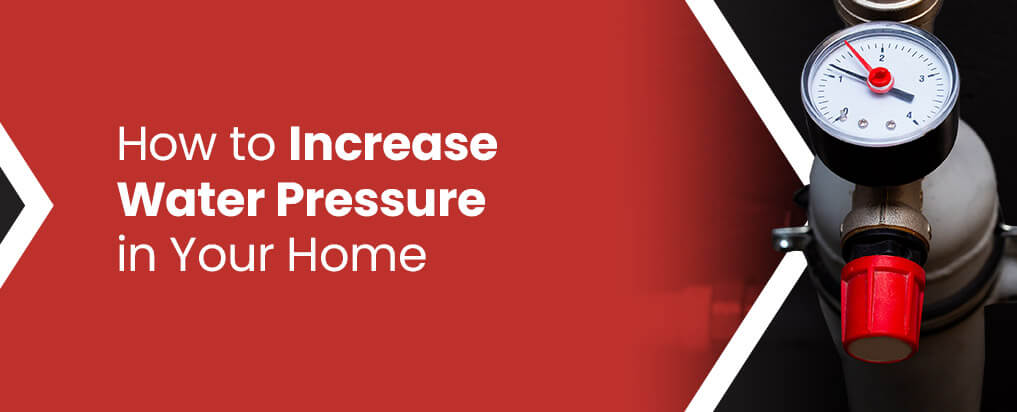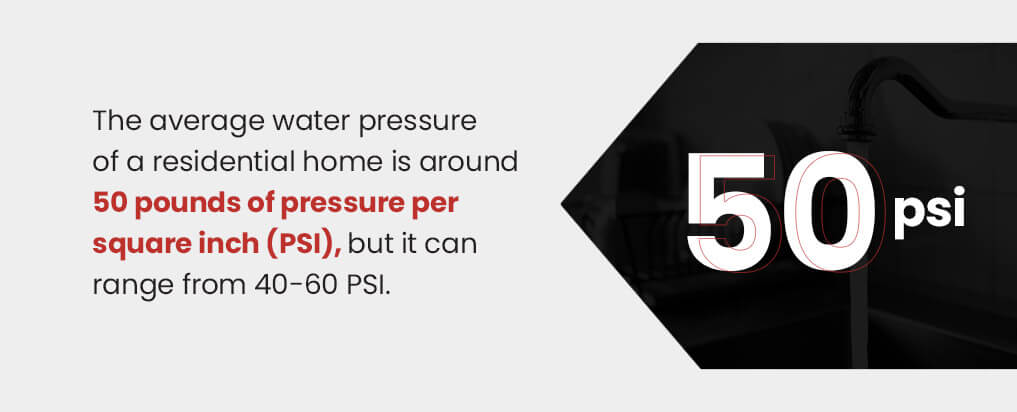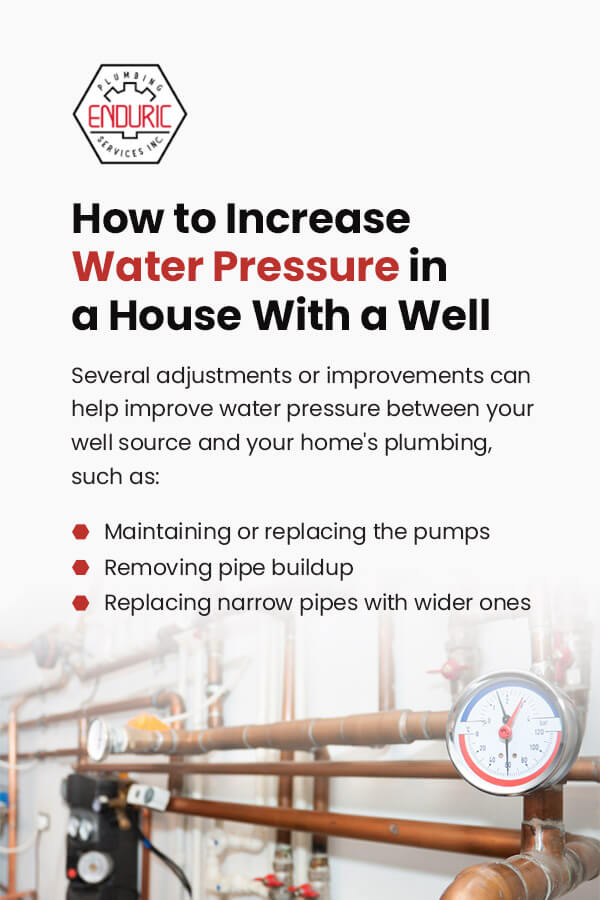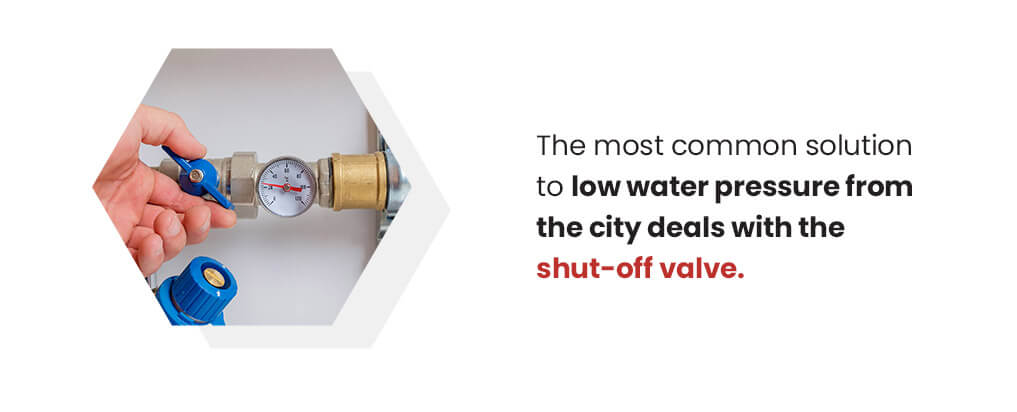
August 23, 2022
When water leaks from the kitchen faucet, the washing machine takes forever to fill, the showerhead in your bathroom is weak and you can’t use multiple appliances at once, you have a low water pressure situation on your hands. But can water pressure be increased in a home without major installations? Are there do-it-yourself (DIY) steps you can take? And when is it the right time to rely on a certified plumber?
Enduric Plumbing Services is a full-service plumbing company that helps diagnose your water pressure. Our technicians are up-to-date on new systems and technology to fix your plumbing issues and ensure long-term solutions. Whether you want to learn how to increase water pressure in an older home or are looking for an easy solution, below are various low water pressure scenarios and their different solutions.
How to Check Your Home’s Water Pressure
Low water pressure is a common plumbing problem that can stem from different issues, but in many cases, it takes minimal time, money and effort to get your water back to flowing normally.

The first step is to confirm your home’s water pressure is, in fact, lower than normal. The average water pressure of a residential home is around 50 pounds of pressure per square inch (PSI), but it can range from 40-60 PSI. Any reading less than 40 is low and calls for professional help.
Check your home’s water pressure with one of these methods:
- Manual inspection: Using a pressure gauge, tighten the female thread to your outdoor hose faucet or another opening with the same threading. Make sure the valves next to the water meter are opened all the way, then open the hose faucet to maximum pressure. Read the gauge’s needle to determine the current water pressure.
- Call the water department: Another solution is to call your local water department and ask them to conduct a pressure test if you rely on city water. If there is no issue with the municipal’s main water pipe, the issue lies within your home’s pressure.
- Schedule a well-pump inspection: If your home isn’t connected to city water and you have a well, you can contact a well-pump technician to inspect the water pressure.
What Causes Low Water Pressure?
There are several reasons you may experience low water pressure in your home, such as:
- Mineral deposit buildup.
- City water policies or system issues.
- A damaged or loose pressure-reducing valve.
- Leaking pipes.
- A closed water valve.
The most common cause of inadequate water pressure is a leaky pipe. When water leaks from the system, it means the closed loop has been compromised and is no longer being maintained. As water leaks from the pipe, it also weakens the maintained pressure level.
The most obvious way to tell if you have a leaky pipe is if water is physically dripping from your appliances, like around the toilet or a faucet. However, if you suspect a leak but don’t see excess water anywhere, you can conduct a simple test by following these steps:
- Turn off all your faucets and make sure no appliances are running.
- Turn off your home’s water valve and write down the number on the meter.
- After two or more hours, take another meter reading.
- If the number increases, it indicates a leak.
Call a professional plumber to locate the issue and replace the leaky pipe with new material that’s corrosion resistant.
Possible Quick Fixes for Low Water Pressure
If you experience low water pressure in one appliance like a toilet or faucet but not any others, a leak may be out of the question, and a clogged pipe may be the culprit. A professional can help locate and clear the clog.
In some cases, water deposits can form and block the flow of water in things like showerheads. This is typically an easy fix — soak the showerhead in a solution to break up the deposits, and you should be good to go.
If your pressure issue stems from a problem with the valve, you have several options. In the case of a damaged pressure-reducing valve, replacements are easy, and a professional can help if you’re unsure how to proceed. If a closed water valve is causing lower pressure, it’s a simple matter of opening it all the way.
These are examples of a few quick fixes, but there are several other troubleshooting techniques you can try to increase water pressure inside your home.
2 Easy Solutions to Increase Water Pressure
Once you confirm the water pressure in your home is lower than average, you can work toward troubleshooting the issue. Fortunately, there are two easy solutions that can get your water pressure back to an average PSI reading of about 50 — a pressure-reducing valve and a water pressure booster.
While these are two simple solutions, troubleshooting can vary depending on the type of water system you have, like a water well, overhead tank or city water. Try troubleshooting the issue depending on your situation before buying any parts or attempting a DIY fix.
1. Pressure-reducing Valve
In some cases, simply adjusting the pressure-reducing valve in your home can mitigate the issue. Check the main water supply pipe and find the valve next to the meter. You can tighten or loosen the bolt at the top of the valve to increase or decrease water pressure respectively.
Tighten the bolt in small increments at a time, then use the pressure gauge to see when you reach the right PSI between 40 and 60.
2. Water Pressure Booster
The second quick fix is to install a water pressure booster. You can call in the professionals for this one, or you can consider this a DIY project, depending on your know-how. The first step is to attach the pressure booster pump to the main water line that connects to the house.
Attach the output to the water pressure tank and the tank’s output to the house pipes to create a closed loop. A pressure booster is a powerful electric pump that cuts into the water line and turbo charges the water pressure to reach the correct PSI. You can adjust the booster to what your household prefers.

How to Increase Water Pressure in a House With a Well
Wondering how to improve pressure if you receive water from a well? You’re not at a loss of luck. Homeowners consistently struggling with low water pressure or a fluctuating well system can typically increase water pressure like they would with any other system.
Several adjustments or improvements can help improve water pressure between your well source and your home’s plumbing, such as:
- Maintaining or replacing the pumps: In some cases, low water pressure in a well often relates to the centrifugal or submersible pump or the jet pumps. If any of these components operate for an extended period with no maintenance or service, they will likely need to be inspected by a certified plumber.
- Removing pipe buildup: Well water has a higher concentration of minerals like calcium, iron and magnesium. These elements can build over time inside the pipes and cause low water pressure. To reduce hard water like this, you can install a softener or add a filter to break up the elements.
- Replacing narrow pipes with wider ones: Small, narrow pipes can also contribute to poor well water pressure. You can easily have the professionals replace these with wider pipes.
You can also use one of the two easy steps mentioned above, such as adjusting the pressure tank setting or installing a water pressure booster. Depending on the age of your well water system, it could also be time for an upgrade.
Consider installing a well pump with a higher flow capacity, which is measured by gallons per minute (GPM). You could also get a constant pressure system, which may help if you experience fluctuating pressure. The constant pressure system signals the well pump to begin refilling as soon as it senses a drop in pressure to ensure a consistent flow of water.
How to Increase Water Pressure Without a Pump
If your home doesn’t rely on well pumps and your water comes from the city system, the first step is to talk with your neighbors. If your neighborhood is also experiencing low water pressure, it indicates a municipal water system complication and not an issue within your home. Corrosion, leaks and buildups can happen within the larger network as well, not just individual residential homes. In this case, call your local water department for an update and assistance.
If the municipal water system is fine and it’s your home that’s having water pressure complications, check all faucets in the house, including outdoor hoses. Is one or all of them low on pressure? If only the showerhead is slow, it’s most likely a buildup of mineral deposits. If only the toilet is low, it’s most likely a leak somewhere in the plumbing or water lines. If everything is low, it’s most likely a partially open water valve, or you need to increase the pressure-reducing valve. A professional can offer the most accurate diagnosis.

The most common solution to low water pressure from the city deals with the shut-off valve. Find the shut-off valve on your water meter and ensure it’s fully open. Even if it looks open, make sure to push it all the way, because even the slightest closure can affect your home’s water pressure. However, if you open the valve and the pressure still seems low, it’s time to call in the professionals for assistance and additional troubleshooting.
How to Increase Water Pressure From an Overhead Tank
If you don’t have a well or city water and have an overhead water tank installed in your home, your go-to solution often circles back to the water pressure booster. If you choose this route, it’s best to consult a certified plumber. Water pressure pumps can range in size, style and price, so it’s a great idea to work with a trained technician. They can troubleshoot the issue and find the best solution for your situation. A DIY fix could worsen the issue.
Another easy and quick fix is to simply place the overhead tank higher. Gravity is your friend in this situation because it pulls the water from the tank and into your household appliances. If the water tank is installed lower or parallel to your house, there won’t be enough pressure to reach the bathroom, kitchen, laundry room and other areas all at once.
Finally, you can invest in smaller pipes. Unlike narrow well water pipes that aren’t always beneficial when deposit buildups occur, small-diameter pipes for overhead tanks actually increase water pressure. The narrower the pipe, the higher the pressure and vice versa.
Benefits of Maintaining Consistent Water Pressure in Your Home
Understanding how to increase water pressure in a pipe through different scenarios, applications and solutions can change your daily lifestyle. Your first thought when lowering water pressure may be that you’re saving water and using only what you need. However, you could also be wasting money and water through leaks or using more water to complete household tasks like rerunning the washer or handwashing dishes after using the dishwasher.
You may not think weak water pressure throughout your home is a concern, but when you or a plumber gets it back to an average PSI, you can take advantage of things like:
- Not paying for leaking water that’s not being used.
- Meeting your household’s needs, even at peak usage.
- Obtaining a more energy-efficient plumbing system.
- Maintaining your plumbing fixtures and home appliances.
- Implementing positive maintenance and cleaning habits for your household plumbing and water lines.
With the right water pressure meeting your home appliance needs, you’ll be taking advantage of an energy-efficient plumbing system. The correct PSI also helps maintain your plumbing fixtures and household machines. If the PSI is too high, the water can bust your pipes, while a low PSI can lead to corrosion and increase buildup.
With residential water pressure at the correct PSI reading, your home will experience several long-term advantages.
Call The Professionals at Enduric
Before attempting any DIY projects to increase water pressure in your home, troubleshooting is the first step. Determine whether the low pressure stems from deposit buildups, a closed water valve, leaks, a loose pressure-reducing valve or a municipal water issue. If there isn’t an obvious cause — or you prefer to trust your home to our experienced team of professionals — reach out to the experts at Enduric Plumbing Services for assistance.
We deliver high-quality work and excellent customer service throughout the entire process. Our plumbing technicians diagnose the cause of low water pressure in your home, troubleshoot the issue and determine a solution that supports your exact situation. We help you feel confident in the final decision by explaining the issues we see and how we can best fix your system.
Reach out to us online for a comprehensive quote, or call an Enduric representative for more information about your home’s water pressure at (336) 829-1066.



